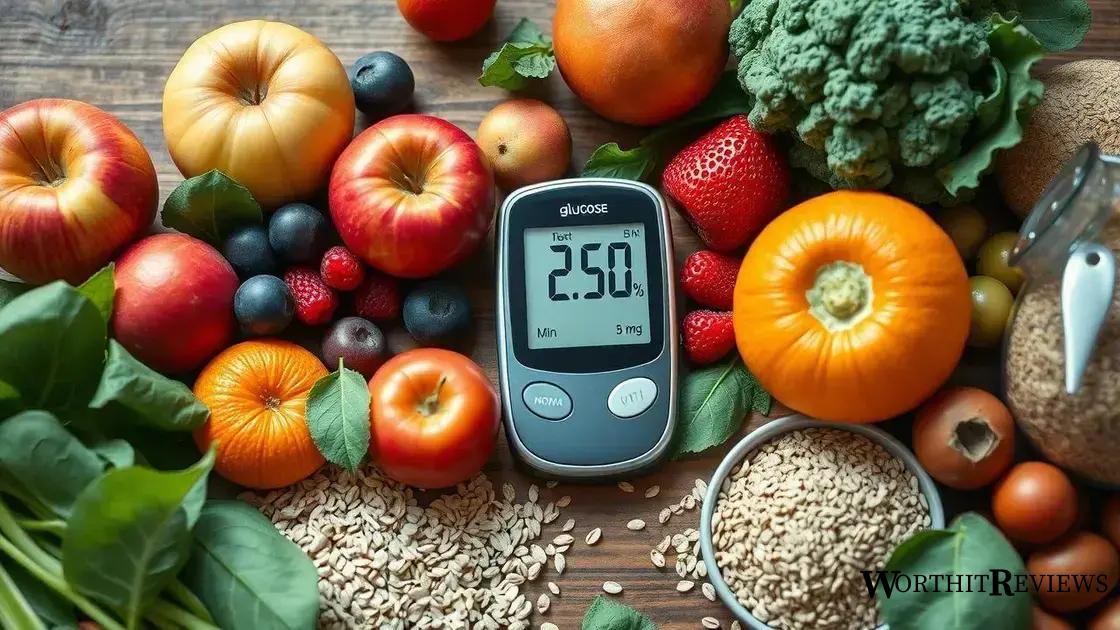Blood sugar readings for type 2 diabetes should be closely monitored, with ideal fasting levels between 80-130 mg/dL and post-meal levels under 180 mg/dL, to effectively manage the condition and prevent complications.
Blood sugar readings for type 2 diabetes play a vital role in your daily management of the condition. Have you ever wondered how these numbers impact your overall health and what they mean for your future? Let’s dive in.
Understanding blood sugar readings
Understanding your blood sugar readings is essential for managing type 2 diabetes. These readings help you monitor how well your body processes glucose, which can affect your overall health.
What are Blood Sugar Readings?
Blood sugar readings indicate the amount of glucose present in your bloodstream at a specific time. They are usually measured in milligrams per deciliter (mg/dL). Knowing whether your levels are too high or too low can help you make informed decisions regarding your diet, activity level, and medications.
Why Are Blood Sugar Levels Important?
Monitoring blood sugar levels is critical because high blood sugar (hyperglycemia) can lead to serious long-term complications such as heart disease, kidney damage, and vision loss. Conversely, low blood sugar (hypoglycemia) can cause symptoms like dizziness, confusion, and even loss of consciousness if not treated promptly.
How to Interpret Blood Sugar Readings
Blood sugar levels can vary throughout the day based on meals, physical activity, and stress. Generally, the target fasting blood sugar level for someone with type 2 diabetes should be between 80 and 130 mg/dL. After meals, levels should be less than 180 mg/dL one to two hours after eating.
When to Check Your Blood Sugar
It’s important to check your blood sugar regularly, especially before meals and after exercise. Your doctor may recommend testing more frequently if your levels are less stable. Keeping a record of your readings can also help identify patterns that can be discussed with your healthcare provider.
Understanding your blood sugar readings is a powerful tool in managing diabetes. Armed with this knowledge, you can work with your healthcare team to make adjustments and improve your health outcomes.
Ideal blood sugar ranges for type 2 diabetes

Maintaining the ideal blood sugar ranges is crucial for managing type 2 diabetes. Knowing these ranges helps you keep your glucose levels under control and reduce the risk of complications.
Normal Blood Sugar Levels
For most individuals without diabetes, normal blood sugar levels fall between 70 and 99 mg/dL when fasting. This means that when you have not eaten for at least eight hours, your readings should be within this range.
Target Ranges for Type 2 Diabetes
For those managing type 2 diabetes, target blood sugar levels are slightly different. The recommended fasting range is between 80 and 130 mg/dL. Post-meal blood sugar levels, measured one to two hours after eating, should ideally be less than 180 mg/dL.
Why These Ranges Matter
Staying within these ranges can help prevent both short-term and long-term complications associated with diabetes. High blood sugar levels can lead to damage in vital organs, including your heart, kidneys, and eyes. Conversely, very low levels can induce hypoglycemia, resulting in symptoms like confusion, shaking, and even loss of consciousness.
Monitoring Your Levels
Regularly checking your blood sugar levels can help you understand how your body reacts to different foods, physical activities, and medications. Keeping a log of your readings alongside your meals and activities can provide insights that can be shared with your healthcare provider for better management.
For optimal management of type 2 diabetes, aim for these ideal blood sugar ranges and consult your healthcare team for personalized guidance.
How to measure your blood sugar levels
Measuring your blood sugar levels is a crucial part of managing type 2 diabetes. Regular checks can help you stay informed about your health and make necessary adjustments to your treatment plan.
Choosing the Right Equipment
To measure your blood sugar, you’ll need a few items. A glucose meter is essential, and many people also use test strips and a lancing device to obtain blood samples. Ensure that your meter is properly calibrated and that you have enough supplies for consistent testing.
Steps to Measure Your Blood Sugar
1. Wash your hands with soap and water or use an alcohol wipe to keep the area clean.
2. Insert a test strip into the glucose meter.
3. Use the lancing device to prick the side of your fingertip for a blood sample.
4. Touch the drop of blood to the test strip and wait for the result. Most meters show readings in just a few seconds.
When to Measure
Timing can vary based on your doctor’s recommendations, but it often includes:
– Fasting levels in the morning before eating.
– One to two hours after meals to check how foods affect your blood sugar.
– Before and after exercise to understand how activity impacts your levels.
Interpreting the Results
Understanding your readings helps you make informed decisions about your health. Typically, fasting levels should be between 80 and 130 mg/dL, and post-meal levels should be less than 180 mg/dL. If your readings are consistently outside these ranges, consult your healthcare provider.
By measuring your blood sugar levels regularly, you can take charge of your diabetes management and work closely with your healthcare team to create a plan that fits your needs.
Factors influencing blood sugar readings

Several factors can influence blood sugar readings, making it essential for individuals with type 2 diabetes to understand these variables. Being aware of these factors can help you manage your health more effectively.
Dietary Choices
The foods you eat play a significant role in blood sugar levels. Consuming carbohydrate-rich foods can cause spikes in blood sugar, while fiber-rich foods can help stabilize it. It’s essential to monitor your meals and understand how they impact your levels.
Physical Activity
Exercise has a profound effect on blood sugar levels. Being active helps your body utilize insulin more effectively, which can lower blood sugar levels. Regular physical activity, such as walking or swimming for at least 30 minutes a day, is recommended.
Stress Levels
Both physical and emotional stress can raise blood sugar levels. When you experience stress, your body releases hormones like cortisol and adrenaline, which can increase glucose production. Finding effective stress management techniques, such as meditation or deep breathing, can lead to better blood sugar control.
Medication and Treatment Plans
Your prescribed medications significantly affect your blood sugar levels. It’s crucial to take them as directed and to discuss any changes in your readings with your healthcare provider. Adjustments to your medications may be necessary depending on your blood sugar patterns.
Illness and Health Conditions
Being ill or experiencing other health conditions can influence blood sugar levels as well. Infections, cold, or the flu can lead to higher blood sugar levels due to your body’s increased stress response. Keeping track of these occurrences can aid in managing your diabetes more effectively.
Understanding these factors can help you make informed decisions about lifestyle and treatment choices that support better blood sugar management.
Common misconceptions about blood sugar
There are several common misconceptions about blood sugar that can lead to confusion and poor management for those with type 2 diabetes. Understanding these myths is important for better health outcomes.
Myth: Only Sugar Affects Blood Sugar Levels
Many people believe that eating sugar is the only factor that raises blood sugar levels. However, carbohydrates from various sources, like bread, pasta, and fruits, also affect blood glucose. It’s essential to monitor all carbohydrate intake, not just sugar.
Myth: Eating Fruit Should Be Totally Avoided
Another misconception is that all fruits are bad for blood sugar levels. While fruits contain natural sugars, they also provide fiber and essential nutrients. Choosing whole fruits and enjoying them in moderation can be a healthy part of your diet.
Myth: Blood Sugar Levels are Always High in Diabetes
Some people think that individuals with diabetes always have high blood sugar levels. In reality, blood sugar levels can fluctuate and may sometimes be too low. Regular monitoring is key to understanding these variations and managing diabetes effectively.
Myth: You Can’t Eat Carbs at All
Another common belief is that people with diabetes should completely eliminate carbohydrates. This is not true; instead, it is important to focus on the type and amount of carbohydrates consumed. Opting for whole grains and high-fiber carbs can be beneficial.
Myth: Insulin is the Only Solution for Blood Sugar Control
Many believe that insulin is the only way to manage blood sugar. However, there are various effective methods, including diet, exercise, and oral medications, that can help control blood glucose levels without requiring insulin.
By debunking these common misconceptions, individuals can take more informed steps in managing their blood sugar levels and overall health.
The role of diet in blood sugar management

The role of diet in blood sugar management is crucial for those with type 2 diabetes. The foods you choose can significantly impact your blood glucose levels and overall health.
Understanding Carbohydrates
Carbohydrates are the primary source of glucose in your body. It’s important to understand how different types of carbs affect blood sugar. Simple carbohydrates, found in sugary foods and drinks, can spike blood sugar quickly. In contrast, complex carbohydrates, like whole grains and legumes, digest more slowly and provide more stable energy.
Fiber-Rich Foods
Including fiber-rich foods in your meals can help control blood sugar levels. Fiber slows down the absorption of glucose, preventing spikes in blood sugar. Foods like fruits, vegetables, beans, and whole grains are excellent sources of fiber.
Healthy Fats and Proteins
Incorporating healthy fats and proteins into your meals is also beneficial. Foods such as avocados, nuts, seeds, and lean proteins can help maintain satiety and stabilize blood sugar. They slow the digestion process and can prevent rapid increases in blood glucose levels.
Portion Control
Paying attention to portion sizes is essential in managing your blood sugar. Eating large portions, even of healthy foods, can lead to increased blood sugar. Using smaller plates and measuring servings can help maintain appropriate portion sizes.
Avoiding Processed Foods
Minimizing the intake of processed foods is vital for blood sugar management. Many processed foods contain added sugars and unhealthy fats that can negatively impact blood glucose. Focus on whole, unprocessed foods for the best results.
Making informed dietary choices plays a significant role in effectively managing blood sugar levels. By focusing on balanced meals with the right carbohydrates, fiber, fats, and proteins, individuals can improve their overall health and well-being.
Tools for tracking blood sugar levels
Tracking blood sugar levels is a vital part of managing type 2 diabetes. Fortunately, there are several tools available that can help individuals monitor their blood sugar effectively.
Glucose Meters
The most common tool for tracking blood sugar is a glucose meter. This handheld device measures the concentration of glucose in a blood sample. Users simply prick their fingertip, place a drop of blood on a test strip, and insert it into the meter. Results are usually available within seconds, allowing for quick management decisions.
Continuous Glucose Monitors (CGM)
For those looking for more advanced options, a continuous glucose monitor (CGM) provides real-time blood sugar readings throughout the day. A small sensor is placed under the skin, and it sends data to a device or smartphone app. This tool helps identify trends and patterns in blood sugar levels, offering deeper insights into how food, exercise, and medications affect glucose.
Mobile Apps
There are numerous mobile apps designed to help individuals track their blood sugar levels, dietary habits, and exercise routines. These apps often allow users to log their readings, set reminders for tests, and analyze data over time. Some even offer features for sharing information with healthcare providers, promoting better collaboration in managing diabetes.
Diabetes Management Software
For a more comprehensive approach, diabetes management software can provide in-depth analysis and reporting. These software packages often offer features for tracking blood sugar, medications, carbohydrate intake, and physical activity. They can generate reports that help users and their healthcare teams make informed decisions about treatment plans.
Wearable Devices
New technology has led to the development of wearable devices that can monitor blood sugar levels continuously or track physical activity and diet. Devices such as smartwatches can integrate blood sugar tracking with other health metrics, providing a comprehensive overview of a person’s health.
By utilizing these tools, individuals with type 2 diabetes can take charge of their health and make informed choices to manage their blood sugar levels effectively.
When to consult a doctor about your readings

Knowing when to consult a doctor about your blood sugar readings is essential for managing type 2 diabetes effectively. Timely communication with your healthcare provider can help you maintain better control over your condition.
Consistently High Readings
If your blood sugar readings regularly exceed 180 mg/dL after meals or stay above 130 mg/dL when fasting, it’s important to reach out to your doctor. These levels may indicate that your current management plan isn’t effective and adjustments are necessary.
Frequent Low Readings
Conversely, if you experience low blood sugar levels, typically defined as below 70 mg/dL, you should consult your healthcare provider. Frequent episodes of hypoglycemia can be dangerous and may require a reevaluation of your treatment plan.
Significant Changes in Readings
Any sudden and unexplained changes in your blood sugar readings warrant a consultation. If you notice higher or lower levels than usual without a clear reason, it’s time to discuss this with your doctor.
Symptoms of High or Low Blood Sugar
If you experience symptoms like extreme thirst, frequent urination, fatigue, or blurred vision, you should consult your doctor. Similarly, symptoms of low blood sugar, such as dizziness, confusion, sweating, or shaking, also require medical attention.
Recommendations from Your Healthcare Team
Your doctor may suggest specific times to check in based on your health conditions and management plan. Regular check-ups can help track your progress and make necessary adjustments to your treatment.
By staying informed and proactive, you can ensure you are doing your best to manage your blood sugar effectively and live a healthier life.
In conclusion, understanding blood sugar management is vital for living well with type 2 diabetes
By monitoring your blood sugar readings and knowing when to consult your doctor, you can better manage your health. Dietary choices, regular exercise, and the right tools can make a significant difference.
Debunking common misconceptions about blood sugar helps you make informed decisions. All these factors, combined with proper knowledge, lead to more effective diabetes management.
Managing blood sugar is a journey that requires attention and care, but with the right strategies, you can achieve better health and improve your quality of life.
